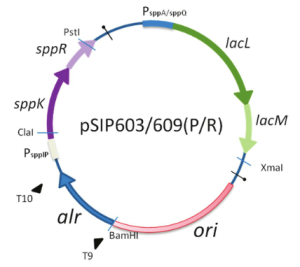Development of food-grade gene expression vectors in lactic acid bacteria
SUPERVISOR: DIETMAR HALTRICH
Project assigned to: MINH HOANG NGUYEN
Background.
Seeking highly efficient food-grade expression vector systems for lactobacilli plays an important role in today's industrial biotechnology and food fermentation. Lactobacilli have a great potential as food-grade cell factories and as delivery vehicles for a broad range of proteins, such as antigens, antibodies and growth factors (Diep, 2009). Thus, there is considerable interest in the development of genetic tools for efficient and controllable gene expression in lactobacilli. Several such gene expression vector systems have been developed. Among these, pSIP expression systems have attracted attention because of their advantages and usefulness. Basically, prototypes of pSIP expression vectors contain the promoter elements PsppA or PsppQ (derived either from the sakacin A or sakacin P structural gene, respectively) as well as a cognate two-component regulatory system and the erythromycin resistance gene as selection marker (Sorvig, 2003).

For food-grade status, the erythromycin resistance gene was replaced by the homologous alanine racemase gene (alr) (Nguyen, 2011). Still there are some drawbacks of these vectors (e.g. expensive inducer, low plasmid copy numbers).
Aims and methods.
This project aims to further develop food-grade expression vectors in lactic acid bacteria allowing high levels of protein expression. To achieve this goal, it is very essential to further develop food-grade vectors based on pSIP vector by:
- Exchanging the promoters in pSIP vectors that need to be induced by expensive peptide pheromones with other strong inducible promoters (which can be induced by cheaper substances) or constitutive promoters
-Replacing the origin of replication to obtain high plasmid copy numbers.
Finally, the expression levels of some target proteins (such as beta-galactosidases from different sources) using these newly developed expression vectors will be evaluated.
To tackle these challenging bottlenecks we will establish a platform for production of soluble and stable proteins and/or protein complexes based on parallel screening of nested constructs in E. coli and employing the cell-free expression systems. Furthermore, we will develop and establish a customized crystallization screening based on the biophysical properties of individual targets.
The efficiency of our protein production and crystallization platform will be assessed and subsequently used on a on a series of different kinds of proteins, mainly building the cytoskeleton of cells, antibodies membrane transporters and enzymes involved in protection from reactive oxidative species.
Diep, D. B., Mathiesen, G., Eijsink, V. G. H., & Nes, I. F. (2009). Use of lactobacilli and their pheromone-based regulatory mechanism in gene expression and drug delivery. Current Pharmaceutical Biotechnology, 10(1), 62-73.
Nguyen, T. T., Mathiesen, G., Fredriksen, L., Kittl, R., Nguyen, T. H., Eijsink, V. G. H., Haltrich, D., Peterbauer, C. K. (2011). A food-grade system for inducible gene expression in Lactobacillus plantarum using an alanine racemase-encoding selection marker. Journal of Agricultural and Food Chemistry, 59(10), 5617-5624.
Sorvig, E., Gronqvist, S., Naterstad, K., Mathiesen, G., Eijsink, V. G. H., Axelsson, L. (2003). Construction of vectors for inducible gene expression in Lactobacillus sakei and L. plantarum. FEMS Microbiology Letters, 229(1), 119-126.
